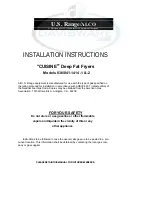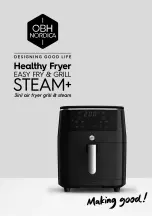
9
Installation
Gas Connection
NOTE: ALL GAS FITTING MUST ONLY BE CARRIED OUT BY AN AUTHORISED PERSON.
1.
It is essential that the gas supply is correct for the appliance to be installed and that adequate
supply pressure and volume are available. The following checks should therefore be made before
installation:-
a.
The Gas Type
the appliance has been supplied for is shown
on the coloured stickers located above the gas connection and
next to the rating plate. Check that this is correct for the gas
supply the appliance is being installed for. The gas
conversion procedure is detailed in this manual.
b.
Supply Pressure
required for this appliance is shown in the
'Specifications' section of this manual. Check the gas supply
to ensure that adequate supply pressure exists.
c.
Input Rate
of this appliance is also stated on the Rating
Plate located inside the door and in the 'Specifications' section
of this manual. The input rate should be checked against the
available gas supply line capacity.
Particular note should
be taken if the appliance is being added to an existing
installation.
NOTE: It is important that adequately sized piping runs directly to the connection joint on the
appliance, with as few tees and elbows as possible to give maximum supply volume.
2.
A suitable joining compound which resists the breakdown action of LPG must be used on every gas
line connection, unless compression fittings are used.
The connection to the appliance is
3
/
4
” BSP male.
NOTE: A Manual Isolation Valve must be fitted to the individual appliance supply line.
3.
Correctly locate the appliance into its final operating position and using a spirit level, adjust the legs
so that the unit is level and at the correct height.
4.
Connect the gas supply to the appliance.
5.
Check all gas connections for leakages using soapy water or other gas detecting equipment.
6.
Check the gas supply pressure is as shown in the ‘Specifications’
section, ‘Gas Supply Requirements’ table.
NOTE: The supply pressure is to be measured at the upper test
point (Supply Pressure) on the gas control valve located
behind the access door and through the access hole in the
control panel.
7.
Light the Pilot Burners. Refer to the ‘Operation’ section, ‘Lighting the
Pilot Burners’.
8.
Check the pilot flame size. Re-adjust if required, using the pilot
adjusting screw (See Fig 3), and as shown in the ‘Gas Conversion and
Specifications’ section, ‘Pilot Burner Flame Adjustment’.
9.
Light the Main Burners. Refer to the ‘Operation’ section, ‘Lighting the
Main Burners’.
Operating
Pressure
Test Point
Supply Pressure
Test Point
Pressure
Adjusting
Screw
Fig 3
WARNING:
D
O
NOT
USE
A
NAKED
FLAME
TO
CHECK
FOR
GAS
LEAKAGES
.
Rating Plate
Location
Fig 2
C
AUTION
Ensure that the tank(s) is / are filled with either water or oil prior to starting
the Main Burners otherwise damage may be caused to the fryer tank(s).












































